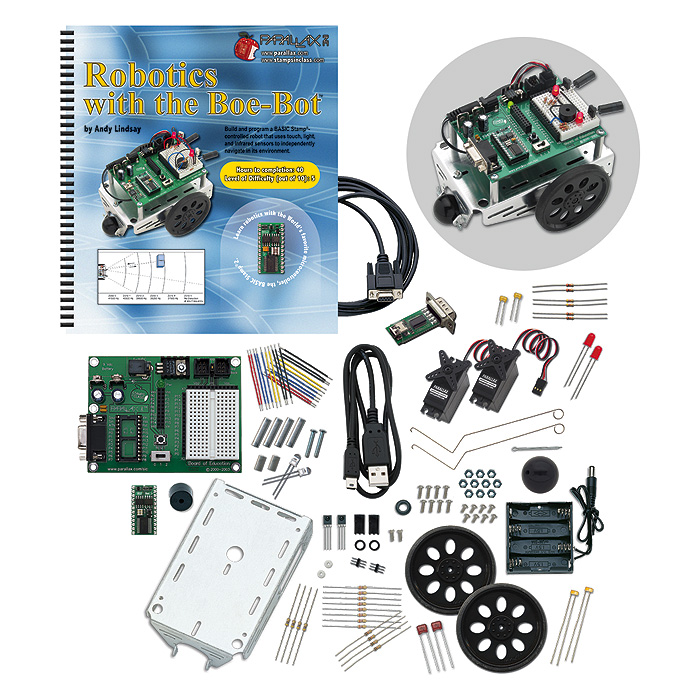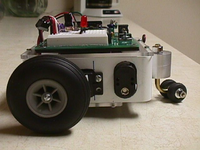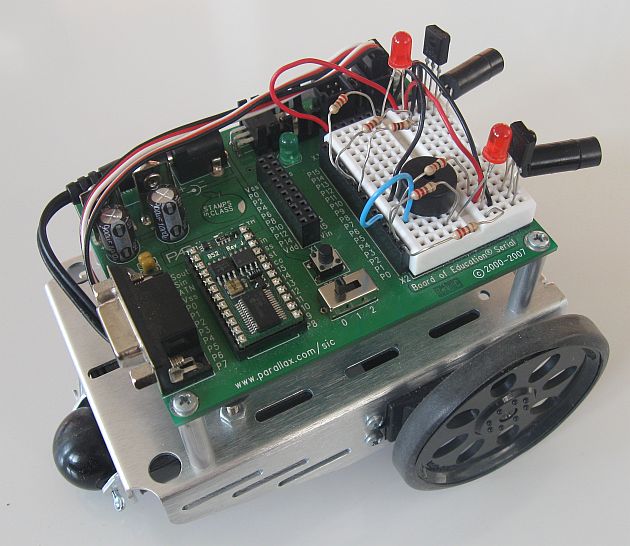Boe-Bot
Boe-Bot is a small mobile robotic kit made by Parallax, Inc. An acromyn Boe in its name stands for Board of Education, the electronic control board, which controls the robot. As its name implies, it is used mainly for education. In this article we will give a brief description of the kit labeled Boe-Bot Robot Kit - Serial (with USB adapter and cable) - order code #28132 selled by the Parallax, Inc. for 160 USD. It can be purchased directly from their e-shop, or from one of their distributors (MITE in the Czech Republic, RLX components in Slovakia).
An idea of the robot appeared a the Idaho University in the Chuck Schoeffler's head. He attached the Board of Education to a plastic box (see Fig. 1). The people in Parallax then draw a CAD design which was cut out of aluminum on the NC machine. So the first Boe-Bots were born. A little bit later a textbook by Andy Lindsay - Robotics with the Boe-Bot appeared and to day there was more than 80.000 (?) robots produced. In the Czech and Slovak republics there is around ?? robots. There are also special courses for teachers and the kits are used in secondary schools and universities not only in America but around the world.
The robot can be built by 12-year pupils, but I can confirm that with a little help from an adult also smallar can handle it. The kit does not require almost no prior robotic knowledge.
 Complete kit (see Fig. 2) contains all the mechanical components
necessary to build a robot. You may need also small tongs or
tweezers, handy screwdriver is bundled with the kit.
Other tools are not necessary. In the box you will find also
a PCB with Board of Education and programming cable.
There exists a kit that has an USB interface directly on
the board and connects using a Mini-USB cable. Version, which
we describe here contains a serial RS-232 cable, plus a small
converter USB/232 with the cable. This version we prefer, as
in our opinion, RS-232 interface is more robust and you also get
the converter to USB, which can be used elsewhere.
Complete kit (see Fig. 2) contains all the mechanical components
necessary to build a robot. You may need also small tongs or
tweezers, handy screwdriver is bundled with the kit.
Other tools are not necessary. In the box you will find also
a PCB with Board of Education and programming cable.
There exists a kit that has an USB interface directly on
the board and connects using a Mini-USB cable. Version, which
we describe here contains a serial RS-232 cable, plus a small
converter USB/232 with the cable. This version we prefer, as
in our opinion, RS-232 interface is more robust and you also get
the converter to USB, which can be used elsewhere.
Part of the kit is excellent 345-pages manual and a CD-ROM with all the necessary software. Finally, you will find some other components (LEDs, resistors, sensors, spacers) in a box that you will use in experiments according to the examples in the book.
Robot can be built in half an hour. It's base is an aluminum chassis to which You have to attach two motors and wheels, four AA batteries holder and a rear wheel (castor). It is a ball made of polyethylene, which is attached to the frame with split pin. Finally, on spacers you will attach the electronics board. Voila, the robot is ready for programming (see Fig. 3)!
Pristavme for a moment on board Board of Education (Fig. 4). Her heart is BasicStamp II processor. It is actually a tiny printed circuit board (31 mm x 16 mm x 9 mm), which apparently acts as a self-functioning microcomputer microprocessor Microchip PIC 16F57 and PBASIC language interpreter. As program memory and hard data is used by an external serial EEPROM memory, the variables are stored in internal RAM. In addition BasicStamp microcomputer (1) includes control board with power stabilization circuitry so. low-drop stabilizer LM2940 (2) and LED indicator (3), 9V battery connector for adapter (4), RS-232 connector (5), connector for expansion modules (6) and connectors for motors (7). Board is switched on / off switch (8) with three positions (OFF - enabled everything except the engine - everything is turned on). Roughly one third of the plate occupies universal contact field (9) is brought near the power supply and processor ports. This section is used for various experiments and engage their own circuits. Tile Board of Education is also Boe-Bot robot used in many other educational kit company Parallax (eg What is a microcomputer, Applied Sensors, etc.).
Almost every experiment with robots according to the manual requires an open area involve any additional electronic components - whether it's only LED indicator, or complicated ultrasonic sensor. The microprocessor has brought out all available ports in the neighborhood, so simply connect your new transmitter to the processor and you can start programming.
How to actually programmed robot?
For beginners can use a simple graphical programming language Gui-Bot, in which the program consists of a sequence of several graphical elements (Fig. 5). For routine work with a robot is used PBASIC programming language. Language commands are translated to the so-called first. tokens, and those to be loaded into the EEPROM memory processor. From there they gradually selects and carries a built-in PBASIC language interpreter. Used to work freely available development environment Basic Stamp Editor for Windows (there are also solutions for MAC and Linux).
Working with digital inputs and outputs can do with commands IN, HIGH and LOW. For more demanding applications are available FREQOUT commands (the signal frequency to any output), PULSIN (measuring pulse length of input), SHIFTOUT (at the output sequentially sends the specified sequence of pulses can be used for serial communication to peripherals) or PULSOUT (pulse specified length of output). Orders are likely to be familiar to readers of the series of processors in Picaxe Robotrevue. The last-mentioned order PULSOUT (see also Robotrevue 02/2010) is also used to control the modified RC servo motors, which drive the robot. When you run this command, unfortunately, also one of the limitations of the programming language used. During the instructions PULSOUT processor is doing nothing, given only the output of pulses. So you can also watch a sensor and respond as promptly as an obstacle. You must program morsel whose rapid recurrence of an impression of "current" movement and sensing parameters. In simple programs this is not a significant problem, but as your programs become more and more complicate, you will also bundle more and more hands.
When debugging is very good built-in terminal device to which you can print various reports showing the current state variables and the like. Messages sent from the robot via a serial interface commands and DEBUG can display them on any terminal - one is directly part of the development environment.
TODO Preview / y
The entire guide contains dozens of tasks, which will gradually be transferred through all the basic components of the robot. Enable you to understand the depth nielen how the robot moves, but also how to interpret the world using simple sensors. At the end of each chapter is the number of open issues, which the authors present the reader to address the deficiency, which leads to a substantial deepening of the problem. After mastering the foundations of movement, change direction and speed and acceleration followed by a chapter in which the characters in the annexed parts of two antennae - the bumpers. With them, you try mobile robot navigation and motion without an accident - detection of obstacles, walls. Other attempts to deal with sensor photoresistors. These allow the search light and dark places, where track lighting spots of batteries. Finally the manual is dedicated to working with modulated infrared sensors, which serve very well to detect obstacles and avoid them. These sensors can be used to estimate the distance from building and maintaining a constant distance from it (basic control).
How to proceed?
After the development of all the examples listed in the guide can do their own experiments, or you buy some accessories. Perhaps the simplest is complementary to infrared remote control, which is available again very detailed instruction manual. Since the driver can also be found at home and guide can be downloaded free from the manufacturer's website, it is certainly worth a try. Another typical application for a mobile robot is tracking the line. Also you can try - there is a kit with four infrasenzormi which attach to the studs and spacers with a detailed manual to understand how to program a robot to monitor whether white or black line. Of course, it is possible to design and make your own and sensor.
The robot is sold as a simple gripper. There is a kit allowing the robot to redo the belt, or even to šesťnohého walking robot. On another article published by expanding the list of sensors - compass, accelerometer, ultrasonic, or encoders in the wheels, allowing for more precise position control of a robot.
Evaluation
For someone who may be a disadvantage PBASIC programming language, which does not create custom functions or libraries. Experienced will surely miss direct access to peripherals processor, and the timer. You will definitely miss the interruption. For beginners, it may even be a problem, even without those features, you get very far. Later you may encounter a lack of RAM and EEPROM, which, however, the school and beginner projects is sufficient. The bottleneck (especially for those who have competitive ambitions) is a robot speed - it uses the drive as modified RC servo is quite slow. The disadvantage may also be its relatively high price.
On the other hand, a higher price you get a robot with the fitting allows a large number of activities, so it's definitely not a time killer for a weekend. It is very robust, durable and suitable for beginners. Very good guide certainly appreciate the end in itself and especially teachers. Not every teacher has the time to create and invent new activities. Textbook, which is part of the kit will provide enough material very well prepared. In addition, teachers may ask the company about slides from the presentations and, where such a version of the brochure, which themselves can translate and edit.
Fig. 8. Robot with infrasenzormi.
If we had a robot BoeBot as compared with the popular Lego Mindstorms, it is clear that the lags in the possibilities of mechanical variability. Boe-Bot is basically a solid structure on which it does not change much. However, the chassis has many holes which make it possible to signal the robot and use a lot of accessories as well as Merkur. Compared stavbnici Lego Mindstorms play Boe-Bot and opportunities in programming, because in addition to other PBASIC language is not available. However, where the Boe-Bot is clearly wins the opportunity for expanding electronics. Through the open access port and universal wiring plate connected to the robot virtually anything. In addition to robotics and motherboard Board of Education allows to know the basics of sensor technology, digital circuits and the like.
It is an excellent entry kit for those who want to deal with robotics more seriously and learn something other than robots of the programming and electronics.
BasicStamp II Technical data
Puzdro 24-pin DIP Rozmery 30,6 x 15,7 x 8,2 mm Frekvencia 20 MHz Rýchlosť cca 4000 inštrukcií/s RAM 32 B (nie kB, len B!) EEPROM 2kB (~500 inštrukcií) I/O 16 (+ 2 sériová linka) Napájanie 5 – 15 Vdc (obsahuje regulátor) Spotreba 3 mA beh / 50 uA spánok @5V Zaťažiteľnosť 20 mA / pin & max. 40 mA / čip
Boe-Bot Technical information
Rozmery: 150 x 114 x 102 mm Hmotnosť: 300 g bez batérií Napájanie: 4 x AA batérie alebo sieťový adaptér Rýchlosť: približne 17 cm/s
Listingy programov
Odkazy
The Boe-Bot Robot – stránka výrobcu s informáciami o stavebnici http://www.parallax.com/tabid/411/Default.aspx
Príručka k robotovi je voľne dostupná tu http://www.parallax.com/Portals/0/Downloads/docs/books/edu/Roboticsv2_2.pdf
Wiki stránka o robotovi http://en.wikipedia.org/wiki/Boe-Bot
Links
Following are links for those who wants to know more:
Documentation
- Boe-Bot robot description (Parallax, Inc.)
- Robotics with Boe-Bot robot (textbook, Parallax)
- Boe-Bot on Wikipedia
Video
- Boe-Bot robot driving square (YouTube video)
- Boe-Bot robot roaming with whiskers (YouTube video)
- Boe-Bot robot roaming with infrared sensors (YouTube video)

